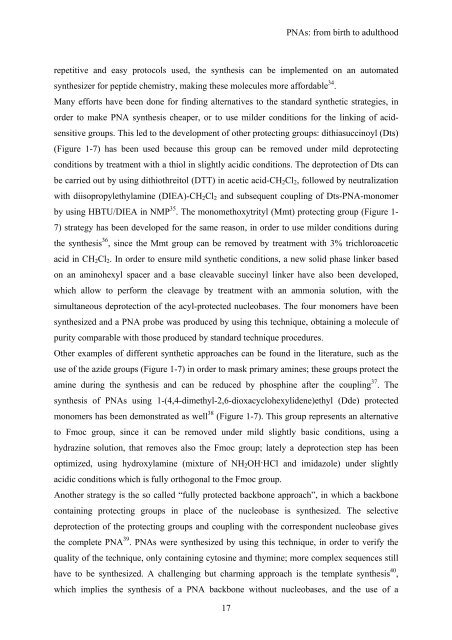View - DSpace UniPR
View - DSpace UniPR
View - DSpace UniPR
You also want an ePaper? Increase the reach of your titles
YUMPU automatically turns print PDFs into web optimized ePapers that Google loves.
PNAs: from birth to adulthood<br />
repetitive and easy protocols used, the synthesis can be implemented on an automated<br />
synthesizer for peptide chemistry, making these molecules more affordable 34 .<br />
Many efforts have been done for finding alternatives to the standard synthetic strategies, in<br />
order to make PNA synthesis cheaper, or to use milder conditions for the linking of acidsensitive<br />
groups. This led to the development of other protecting groups: dithiasuccinoyl (Dts)<br />
(Figure 1-7) has been used because this group can be removed under mild deprotecting<br />
conditions by treatment with a thiol in slightly acidic conditions. The deprotection of Dts can<br />
be carried out by using dithiothreitol (DTT) in acetic acid-CH 2 Cl 2 , followed by neutralization<br />
with diisopropylethylamine (DIEA)-CH 2 Cl 2 and subsequent coupling of Dts-PNA-monomer<br />
by using HBTU/DIEA in NMP 35 . The monomethoxytrityl (Mmt) protecting group (Figure 1-<br />
7) strategy has been developed for the same reason, in order to use milder conditions during<br />
the synthesis 36 , since the Mmt group can be removed by treatment with 3% trichloroacetic<br />
acid in CH 2 Cl 2 . In order to ensure mild synthetic conditions, a new solid phase linker based<br />
on an aminohexyl spacer and a base cleavable succinyl linker have also been developed,<br />
which allow to perform the cleavage by treatment with an ammonia solution, with the<br />
simultaneous deprotection of the acyl-protected nucleobases. The four monomers have been<br />
synthesized and a PNA probe was produced by using this technique, obtaining a molecule of<br />
purity comparable with those produced by standard technique procedures.<br />
Other examples of different synthetic approaches can be found in the literature, such as the<br />
use of the azide groups (Figure 1-7) in order to mask primary amines; these groups protect the<br />
amine during the synthesis and can be reduced by phosphine after the coupling 37 . The<br />
synthesis of PNAs using 1-(4,4-dimethyl-2,6-dioxacyclohexylidene)ethyl (Dde) protected<br />
monomers has been demonstrated as well 38 (Figure 1-7). This group represents an alternative<br />
to Fmoc group, since it can be removed under mild slightly basic conditions, using a<br />
hydrazine solution, that removes also the Fmoc group; lately a deprotection step has been<br />
optimized, using hydroxylamine (mixture of NH 2 OH·HCl and imidazole) under slightly<br />
acidic conditions which is fully orthogonal to the Fmoc group.<br />
Another strategy is the so called “fully protected backbone approach”, in which a backbone<br />
containing protecting groups in place of the nucleobase is synthesized. The selective<br />
deprotection of the protecting groups and coupling with the correspondent nucleobase gives<br />
the complete PNA 39 . PNAs were synthesized by using this technique, in order to verify the<br />
quality of the technique, only containing cytosine and thymine; more complex sequences still<br />
have to be synthesized. A challenging but charming approach is the template synthesis 40 ,<br />
which implies the synthesis of a PNA backbone without nucleobases, and the use of a<br />
17
















